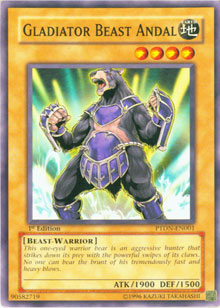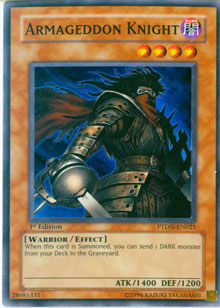This article was written in a hotel room in Indy one night during Gen Con. Being a Shonen Jump weekend I had spent the last week and the days leading up to the event thinking Yu-Gi-Oh!. I was fascinated by how Gladiator Beast Andal was in a World Championship decklist. Of course Worlds had always been a unique tournament. Fewer rounds and weaker decks allow cards that don't make the cut on the SJC circuit to be played. But this year was different.
Gladiator Beasts and Lightsworn were clearly the best two choices, so Andal was definitely a counter-pick for those decks. Obviously the information could be transferred over to the North American metagame. I feel like I improved my game a ton when I wrote this article by realizing just how many ways the battle phase could be used to advance your position. Perhaps more importantly, I learned how you need to apply the knowledge of what you want to do to your deck building process.
-Matt
The 2008 World Championships have come to a close, and this year’s tournament brought with it a first to the competitive dueling scene. For the first time since Invasion of Chaos, the champion was playing a normal monster outside of a One-Turn KO deck. Demise OTK is the only other strategy in which a Championship winner was sporting an effect-free monster, but those were just level 4 Insects included simply because they were necessary for Advanced Ritual Art and Doom Dozer.
 Kazuki Mutsuoka played Gladiator Beast Andal because it’s a strong Gladiator. It has 1900 ATK, and that’s about it. Mutsuoka’s use of Andal and the fact that he won with it made a lot of players question their fundamental beliefs. Effect monsters have always been held in higher regard than normal monsters. Even though a bigger monster could easily destroy an effect monster in battle, the versatility of effects has always been too good to pass up.
Kazuki Mutsuoka played Gladiator Beast Andal because it’s a strong Gladiator. It has 1900 ATK, and that’s about it. Mutsuoka’s use of Andal and the fact that he won with it made a lot of players question their fundamental beliefs. Effect monsters have always been held in higher regard than normal monsters. Even though a bigger monster could easily destroy an effect monster in battle, the versatility of effects has always been too good to pass up.
What made Andal such a good choice at Worlds was its effect on Mutsuoka’s opponents. 1900 ATK is a serious wall for Gladiator Beasts. They have no monster that can be normal summoned to attack over it. This means that a Gladiator Beast player will have to use spell or trap cards to take Andal out, allowing you to fire back with your own tricks and your Gladiator Beast effect monsters. In order to accomplish this without Andal, a normal Gladiator Beast deck would have to use Gladiator Beast Laquari. The problem is that Laquari’s 1800 ATK is so much smaller than Andal’s 1900. At 1800 ATK your opponent can bump heads with his or her own Laquari, or send Elemental Hero Stratos to trade off against your Gladiator.
We see this trend occur all the time in current competitive play. Since nobody is using Gladiator Beast Andal, monsters with 1800 ATK are going to be top dogs. Simply summoning Laquari or Stratos on your first turn gives your opponent something he or she has to deal with immediately. Your opponent can’t make a little play to simply destroy your monster in battle. If the opponent does, that player will lose his or her own monster, freeing you up to make a direct attack next turn.
This kind of pressure does a lot more than you might originally think. Your opponent can’t bluff a spell or trap card, because Gladiator Beast Bestiari will just destroy it. Then you’ll have Bestiari on the field or in the graveyard, neither of which bodes well for your opponent. Both will lead to eventual plays with Gladiator Beast Gyzarus, who often transforms into Gladiator Beast Heraklinos.
So if you summon Andal, your opponent is likely left without a good defensive option and he or she will have to pass with no monster on the field. If you have Test Tiger in hand you’ll make Gladiator Beast Secutor happen, and from there you can Herk up. If you want proof that Heraklinos wins games, look no further than Lazaro Bellido’s feature matches at recent premier events. By having a monster with big ATK numbers on the field, you put a damper on your opponent’s ability to play Heraklinos, and at the same time you increase your chances of summoning your own copy. Bet you never thought of Andal like that before.
But there is a monster that has been doing this all along. Elemental Hero Stratos has been considered the best monster in the game by many players for quite some time. He’s taken Destiny Heroes to a level of tournament success few thought they could achieve, and in conjunction with Elemental Hero Prisma he’s beefed up the Gladiator Beast archetype as well. The reason most players run Stratos is because of the free cards you net just by summoning him. Forgetting the secondary effect (which is also useful at times), Stratos is one of the few cards that can immediately replace itself with additional card presence.
 But there are other cards that do that. Armageddon Knight can drop Destiny Hero - Malicious or Necro Gardna to the graveyard, yet despite being playable in threes there are significantly fewer Armageddon Knight cards floating around serious tournaments than there are copies of Stratos. The reason is that Stratos packs a whopping 1800 ATK. Neither Gladiator Beasts nor Dark Armed Dragon players can take down the 1800 attacker with a normal summon of their own. A freshly normal summoned Gladiator Beast Laquari is a poor monster to send into Stratos, and everything else is just too small.
But there are other cards that do that. Armageddon Knight can drop Destiny Hero - Malicious or Necro Gardna to the graveyard, yet despite being playable in threes there are significantly fewer Armageddon Knight cards floating around serious tournaments than there are copies of Stratos. The reason is that Stratos packs a whopping 1800 ATK. Neither Gladiator Beasts nor Dark Armed Dragon players can take down the 1800 attacker with a normal summon of their own. A freshly normal summoned Gladiator Beast Laquari is a poor monster to send into Stratos, and everything else is just too small.
In fact the best answer to your opponent’s Stratos is often one of your own. Monsters like Card Trooper that were used in the past aren’t as playable anymore thanks to the dominance of Gladiator Beasts and the importance of the battle phase. Dipping back down to 400 ATK is exactly what a Gladiator Beast player wants to see. In fact it’s the sudden increase in play Gladiators are seeing that has made raw ATK so crucial.
The hardest thing to grasp about Gladiator Beasts is just how important the battle phase really is. New techniques (like freezing) can win games because those techniques prevent your opponent from effectively using his or her battle phase, while allowing you to take full advantage of yours. Every card that’s played right now in Gladiators is played because it creates some sort of advantage in the battle phase. The most successful Dark Armed and Lightsworn strategies follow the same philosophy.
So it’s no surprise to me that Gladiator Beast Andal was played by the World Champion. With Test Tiger and Elemental Hero Stratos legal in North American tournaments, only time will tell if Andal is good enough to find a place in the standard Gladiator deck. Regardless, the philosophy still holds true. ATK power has always been considered a bonus for great effect monsters. Now it’s becoming clear that ATK power alone may be just what’s needed to take down a strategy that needs to achieve everything through battle.
Funny isn’t it, how obvious the answer can be?
—Matt Peddle